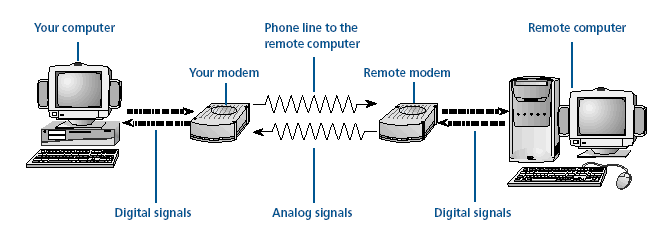
A modem (MOdulator/DEModulator) is a device that translates the digital data of computer communication into analog sound waves that can be transmitted over a voice telephone line. At the other end of the line, another modem converts the sound back into digital data. The diagram below displays how modems send data from one computer to another.

With a modem you can:
| Dial up and exchange information with other computers. | |
| Connect to an Internet service provider (ISP) for email and Web browsing. | |
| Use your computer to send and receive faxes. |
Modems come in both external and internal models. Internal modems are expansion cards you can plug into an expansion slot inside the system unit. An external modem is a peripheral that sits on your desk and plugs into the back of the computer with a serial cable. Most new computers come with an internal modem as standard equipment. Some modems even offer voice mail capabilities ( For example: “to leave a message for Bob, dial 1; to leave a message for Sue, dial 2,” and so on).
A faster modem is useful if you frequently browse the Web. You measure a modem's speed as the bits-per-second of digital data it can transmit over a telephone line under ideal conditions. For example, a 28.8K modem can send and receive data at up to 28,800 bits per second (or about 3,500 bytes per second). Newer modems use a special compression scheme to receive data at nearly 56.6K per second. However, telephone line quality, the facilities of Internet service providers and other factors may modem's actual speed to less than its rated speed.
A cable modem is designed to connect the computer to the Internet over the same wiring that supports cable television. Cable modems can download data at a rate about 200 times faster than standard analog modems. This is because the data-carrying capacity of cable wiring is much greater than the thin copper wires of standard telephone lines.
An ISDN modem allows your computer to connect to the Internet with ISDN service (Integrated Services Digital Network). ISDN modems operate over standard telephone lines. For this reason, they are much slower than cable modem connections. However, an ISDN modem will usually operate faster and more reliably than an analog modem. An ISDN line also allows simultaneous voice and data connections over the same telephone line.